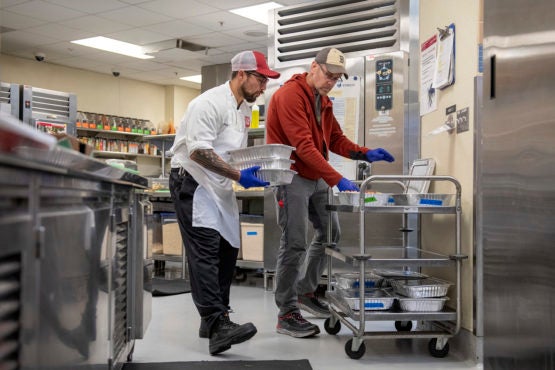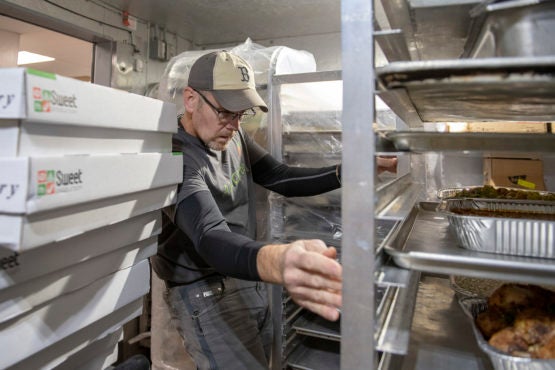Stanford establishes partnership with community ‘food rescue’ organization
Stanford’s Residential & Dining Enterprises has established a new partnership with Silicon Valley Food Rescue, which is dedicated to reducing hunger in the region by distributing surplus food to people in need.
On a recent Friday morning, David Hott, operations director of Silicon Valley Food Rescue, walked into the bustling kitchen of Ricker Dining, which serves the 800 students living in Sterling Quadrangle on the west side of campus.
After exchanging friendly hellos with the staff, Hott washed his hands, put on a pair of gloves and opened the doors of a refrigerator filled with aluminum trays of fresh surplus food that the dining hall had earmarked for donation.

Stanford storekeeper Pedro Zandoval helps David Hott of the Silicon Valley Food Rescue organization to assemble the trays of donated food that will be transported to the community. (Image credit: L.A. Cicero)
To ensure that the food met strict safety standards, Hott tested the temperature of each dish, then covered and labeled each tray. Soon, he had filled a cart with two dozen trays of food, including sautéed carrots, baked chicken and pasta with tomato sauce.
As Hott began rolling the cart out of the kitchen, Mary Duch, general manager of Ricker Dining, called out: “David, I set aside a bag of bagels for you, too. Did you see them?”
It was the first stop of the day for Hott, who spent the morning collecting surplus food at dining halls across campus, under a new partnership between Stanford and Silicon Valley Food Rescue, an organization devoted to reducing hunger in the region.
The organization chose Stanford’s Residential & Dining Enterprises (R&DE) to pilot the initiative, known as A La Carte, which began collecting food on campus late last year.
“Our priority is always to provide excellent meals in a sustainable manner and we have had great success in minimizing the amount of excess food we produce,” said Shirley J. Everett, senior associate vice provost of R&DE.
“I am very pleased that our partnership with A La Carte will ensure that the inevitable excess will support those in our community who need it most.”
Sharing with neighbors
The A La Carte van, emblazoned with the motto “Sharing Meals, Serving Neighbors,” comes to campus five days a week. In addition to dining halls, the refrigerated van stops at other R&DE operations, including cafés at Tresidder Memorial Union, Munger Catering & Events and Stanford Stadium, where R&DE manages the concession stands.

Silicon Valley Food Rescue’s David Hott surveys the food donations set aside in a walk-in refrigerator. (Image credit: L.A. Cicero)
The van delivers the food directly to individuals and families living in nearby communities.
Its current delivery route includes elementary schools – the van arrives at the end of the school day when parents are picking up their children – and apartment complexes that cater to people with disabilities. At each stop, the driver hands out trays of free food from the van’s pass-through window.
Robin Martin, executive director of Silicon Valley Food Rescue, said A La Carte provides a dignified, respectful experience for people who are receiving free food because it looks like any other food truck one might see in their neighborhood.
The van also delivers to community organizations that received surplus food under R&DE’s earlier food donation program, including St. Francis of Assisi Church, which has been receiving frozen food on Wednesdays from Schwab Residential Center for many years.
“St. Francis is now our first delivery stop on Wednesdays,” Martin said. “The church can select as many trays of fresh vegetables, grains and meats as they want. Since they no longer have to thaw the food, they can quickly create a great meal.”
Martin is also working with students from Students for a Sustainable Stanford and Stanford Food Recovery (formerly known as the Stanford Project on Hunger) to coordinate pickups from other locations, including concessions managed by R&DE at Maples Pavilion and at the Faculty Club, which is managed by TDS Foods Inc.
The food rescue program has proven so successful that A La Carte is ordering two more vans and expanding the program to other parts of Silicon Valley. The program is an initiative of Joint Venture Silicon Valley, a nonprofit organization in San Jose.
Staff, students prepare surplus
Employees of Stanford Dining and Stanford Hospitality & Auxiliaries play a critical role in the new food donation program – as they did in the university’s earlier program.
At the end of each meal, they weigh and categorize surplus food and upload the information into waste-tracking terminals for analysis to ensure that the amount of food Stanford is buying and producing doesn’t by itself produce waste. They divide the food by type – protein, vegetables, grains – and pack it into aluminum trays.
Stanford Dining is also training its sustainability food interns on how to prepare food for pickup by A La Carte. Nearly 20 students are now getting first-hand experience preparing food for donation, including Phoebe Richardson, a sophomore majoring in Earth Systems who helps out for about an hour a couple nights a week in Ricker Dining.
Richardson said she has appreciated her time in the kitchen.
“As a student, it’s easy to get detached from food production and preparation, because you walk into the dining hall and there’s food waiting for you,” she said. “All you have to do is grab a plate and take what you want, and at the end of the meal you leave your dishes and someone else takes care of them. Now that I can catch glimpses of the cooking and cleaning, I no longer take meals for granted. It makes me happy that the excess food doesn’t just get thrown out, but that we actually get to pass it on to people who need it.”
